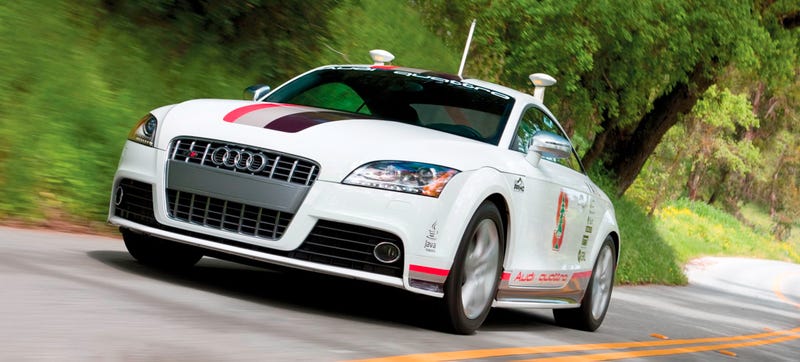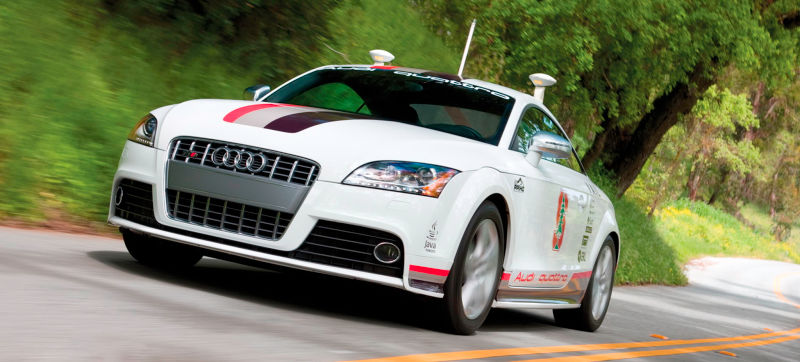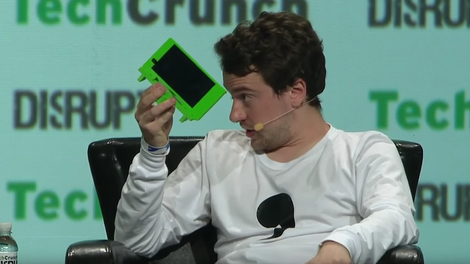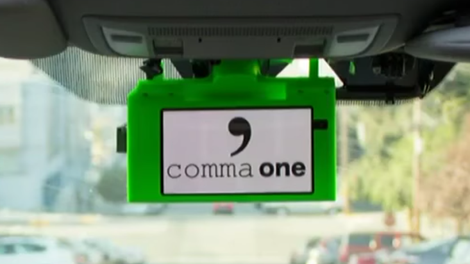
Think about driving home after a long, soul-killing day at work, full of continuous browser window swapping between Facebook, Jalopnik, YouTube and an excel spreadsheet full of random numbers so people think you’re actually working. Do you really want to fight traffic and sit through an endless number of stoplights, when you could be using that valuable time instead to browse Facebook, Jalopnik and YouTube?
Advertisement
Even if you have the most sophisticated Tesla or Volvo or Mercedes, that’s still kind of a pipe dream for now. But imagine pushing a button and instantly turning your car—your current, everyday car—into your personal robotic chauffeur. Autonomous capability that you could turn on and off at will seems pretty appealing, doesn’t it?
Welcome to the world of autonomous driving aftermarket kits. And while they’re still in their earliest stages, they could be a win-win for gearheads everywhere who love to drive—just not in traffic.
Advertisement
Since driverless cars are not only inevitable but increasingly prevalent, whether you want them to be or not, a self-driving kit that you can install in your own car represents the best of both worlds. This means that you get to keep your own car, but it could be autonomous whenever needed. This way, some day, if the government mandates that all cars on the road must drive themselves, you could still hang onto your AMG—as long as it’s outfitted with a self-driving kit. You’ll just have to make sure you don’t illegally sneak in some driving, or this could happen:
Self-driving enforcement officer:Sir, did I see your hands on the wheel?
You: Yes, sorry, can I get a warning this time, please? I just really wanted to drive.
Sponsored
Self-driving enforcement officer: Fine, but next time, no hands on the steering wheel or feet on the pedals—ever. Just sit in the back and look at your phone or something.
Cruise Automation was one of the first startups to create a self-driving kit that would work on normal Audi A4s and S4s. It’s unfortunate that they got acquired by General Motors, because now instead of having badass German rocket-sleds that drive themselves, Cruise Automation is busy turning a Chevrolet Bolt into a roving robot. I suppose they will go down the more lucrative path of making their technology commercially viable instead of building driverless kits for consumers. Can’t blame them.
Advertisement
Advertisement
Luckily other startups have been inspired by Cruise Automation and are trying to do the whole self-driving retrofit thing. The hardware for driverless cars already exists which include things like LIDAR, cameras, radar, sensors. Tesla has already stated that all its newly produced cars will come with the necessary hardware to make them fully autonomous—all that’s remaining is a software update. The software is ultimately what will let the Tesla drive itself and decide which unavoidable obstacle on the road to hit: the pack of innocent adorable schoolchildren, or the litter of adorable puppies.
But don’t worry, you won’t have to face that dilemma—the machine will! Let’s hope that the software can make the right decision. Here are a few of the startups that are working hard to make that happen.
Comma.ai
Advertisement
Comma.ai looked promising early on because its founder, George Hotz actually built a self-driving kit, called the Comma One for $999. Hotz was so convinced they would make it big that he made T-shirts that said “We’re gonna be so rich.”
I guess they will have to wait to be rich, because they shut down operations a few weeks ago. This was in response to the National Highway Traffic Safety Administration when it asked Hotz about what safety measures were in place. Hotz decided that it wasn’t worth it to deal with the government.
Instead, he tweeted this:
Comma.ai’s reaction isn’t surprising, considering that Comma One appeared to be the result of Hotz’s rejection of Musk’s multi-million dollar offer to build a new autopilot system for Tesla. Hotz wanted to prove to Musk that he could build his own self-driving system. But shouldn’t the creation of driverless cars be more about improving safety instead of proving who has the higher IQ?
Advertisement
Advertisement
If I have a 50-50 shot at living or dying every time I get into a driverless car, I’d rather drive myself and be in control of my own fate instead of being powerless and stare straight into the face of death. It’s a good thing that the NHTSA created a 15-point checklist like the FAA does with airplanes to try and make driverless cars as safe as possible.
Drive.ai
Drive.ai is using deep learning to train the software how to drive. Deep learning allows the computer to teach itself new things, improve its current abilities and work on fine-tuning the skill of executing the perfect form of road rage.
Advertisement
Drive.ai is also planning on installing displays on cars that will use emoji to communicate with others so that you can really stick it to the other car that veered into your lane and almost killed you. It might look something like this:
The emojis might look dumb, but if it can get a smile out of you, then maybe it’s worth it. Perhaps someone would be less inclined to come at you with a sledgehammer at a stoplight fuming with road rage if they see a silly angry red face on your car.
In this Entrepreneur magazine article, Drive.ai also said it’s working on building a kit that can be retrofitted on existing cars and has plans to test this soon. I hope it’s publicly available in the near future because I can’t wait to fall asleep in stop-and-go traffic.
Advertisement
Advertisement
Perrone Robotics
Perrone Robotics has been around for a while now, but it’s recently announced a round of funding from Intel Capital. The company’s focus appears to be on more commercial applications, but its drop-in autonomy kit looks intriguing.
According to the company’s site, the kid can be installed in a car in less than 30 minutes—but I’m not sure if you could actually drive the car yourself without taking a few hours to uninstall the whole contraption. Looks like there’s still some work to be done here.
Advertisement
Nuro.ai
A couple of engineers at Google recently quit their self-driving program to go build their own car in supposedly two to four years. Umm… haven’t they learned from Apple? If a company like Apple with hundreds of billions of dollars couldn’t make it work, then Nuro.ai can? Maybe they have Google money as well as talent.
Nuro.ai hasn’t revealed too many specifics about what it wants to do, which is much like how Google likes to operate. Nuro.ai may or may not build self-driving kits but if you look at their site, this is what they’re saying: “We’re doing something different. We think it’s exciting.”
Advertisement
Advertisement
Good, I hope one of those different and exciting things is an easy-to-install self-driving kit for normal cars.
When self-driving does become an everyday thing, however, and we have kits available to install on our cars, it will be like having the best of both worlds. We can turn our cars into a moving theater, eat popcorn while binge-watching The Walking Dead, or when the road clears up—just drive. I could live with that.


















